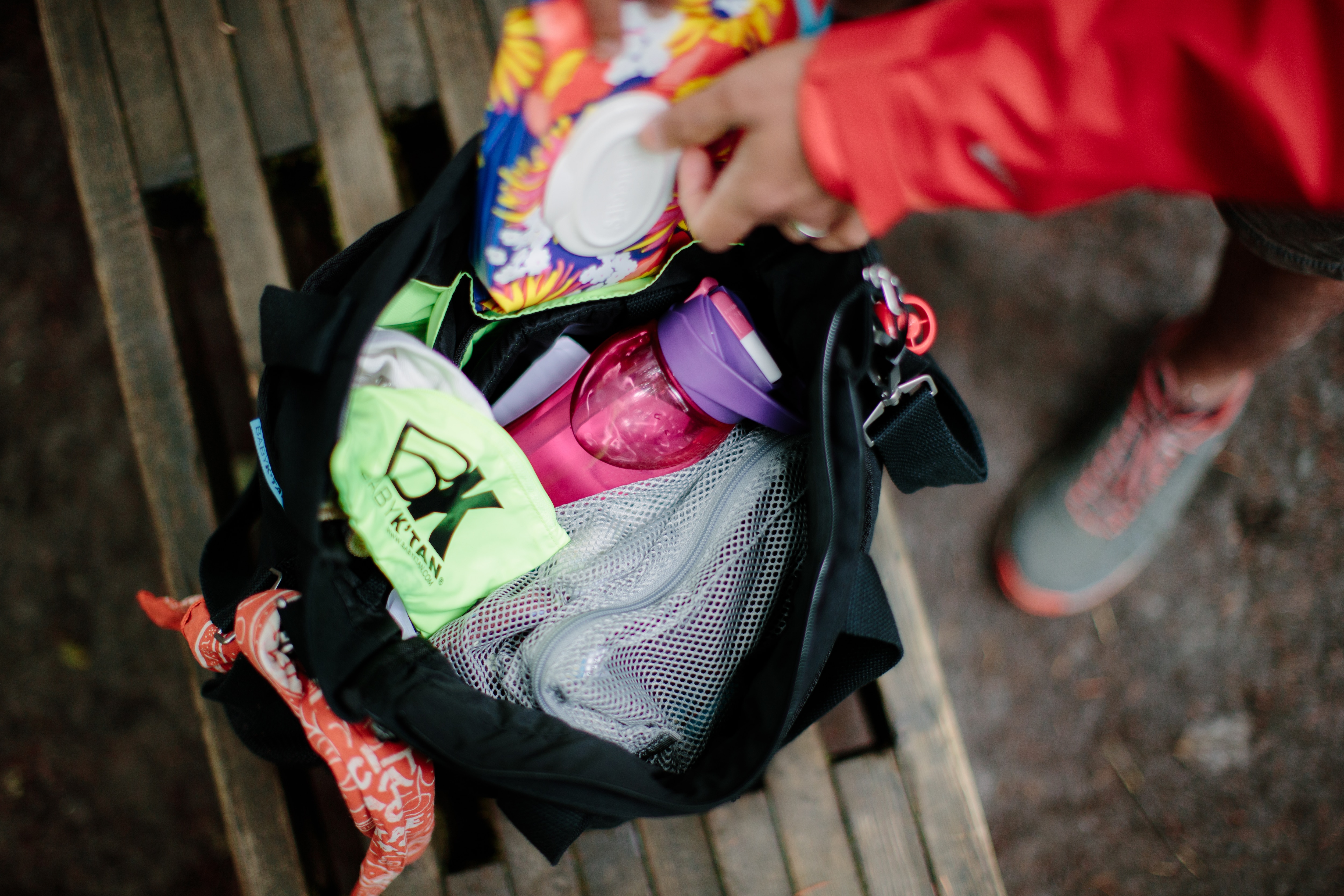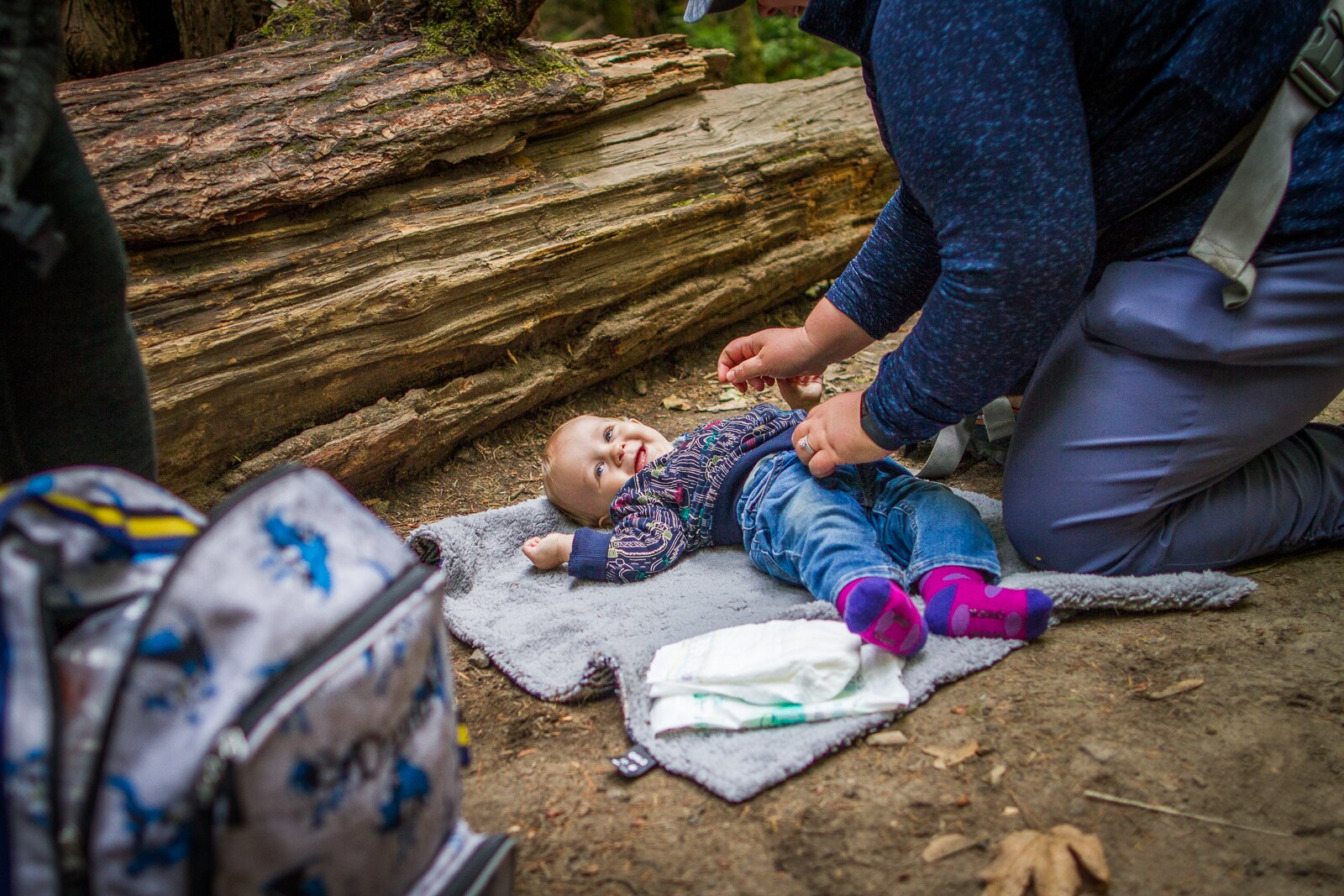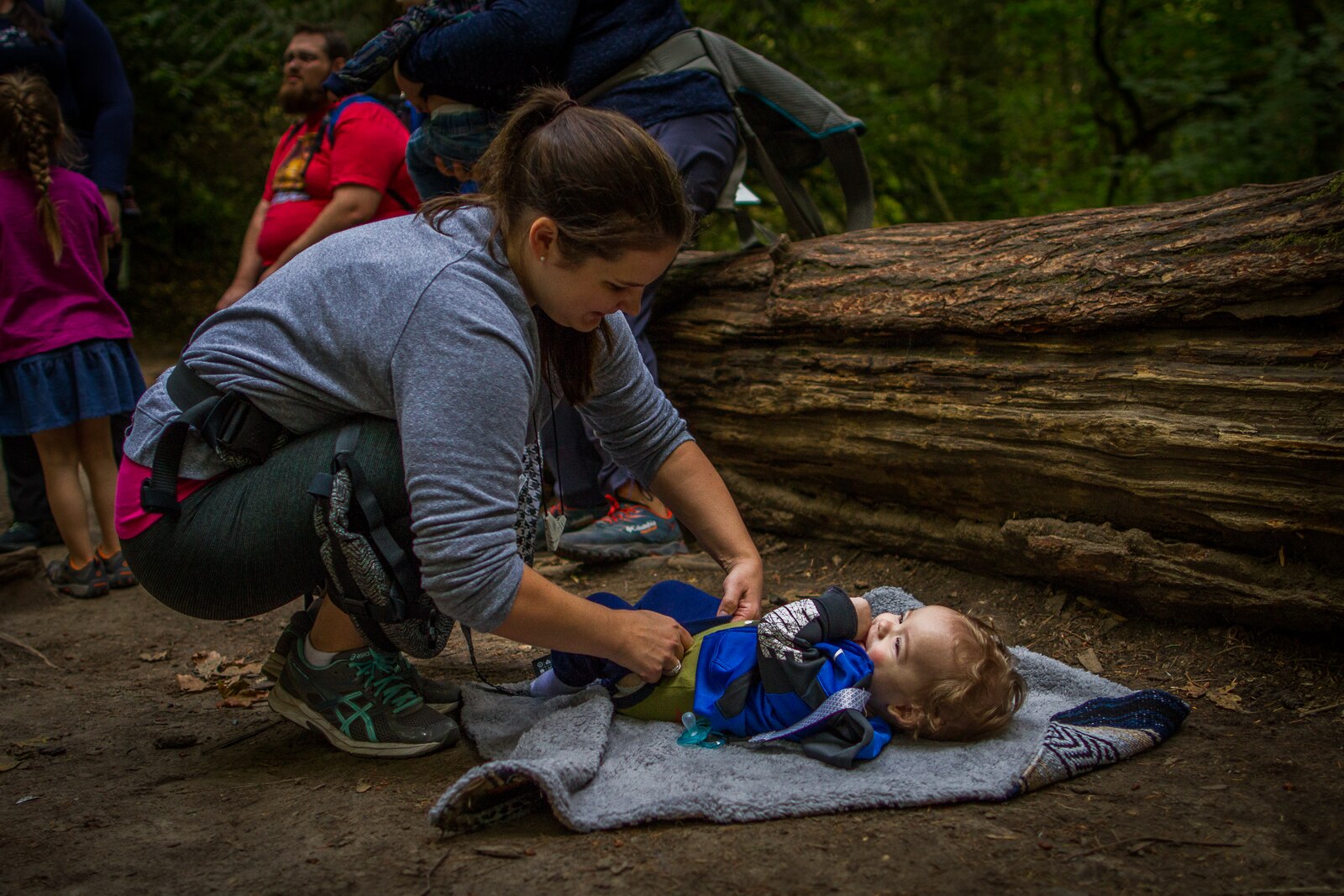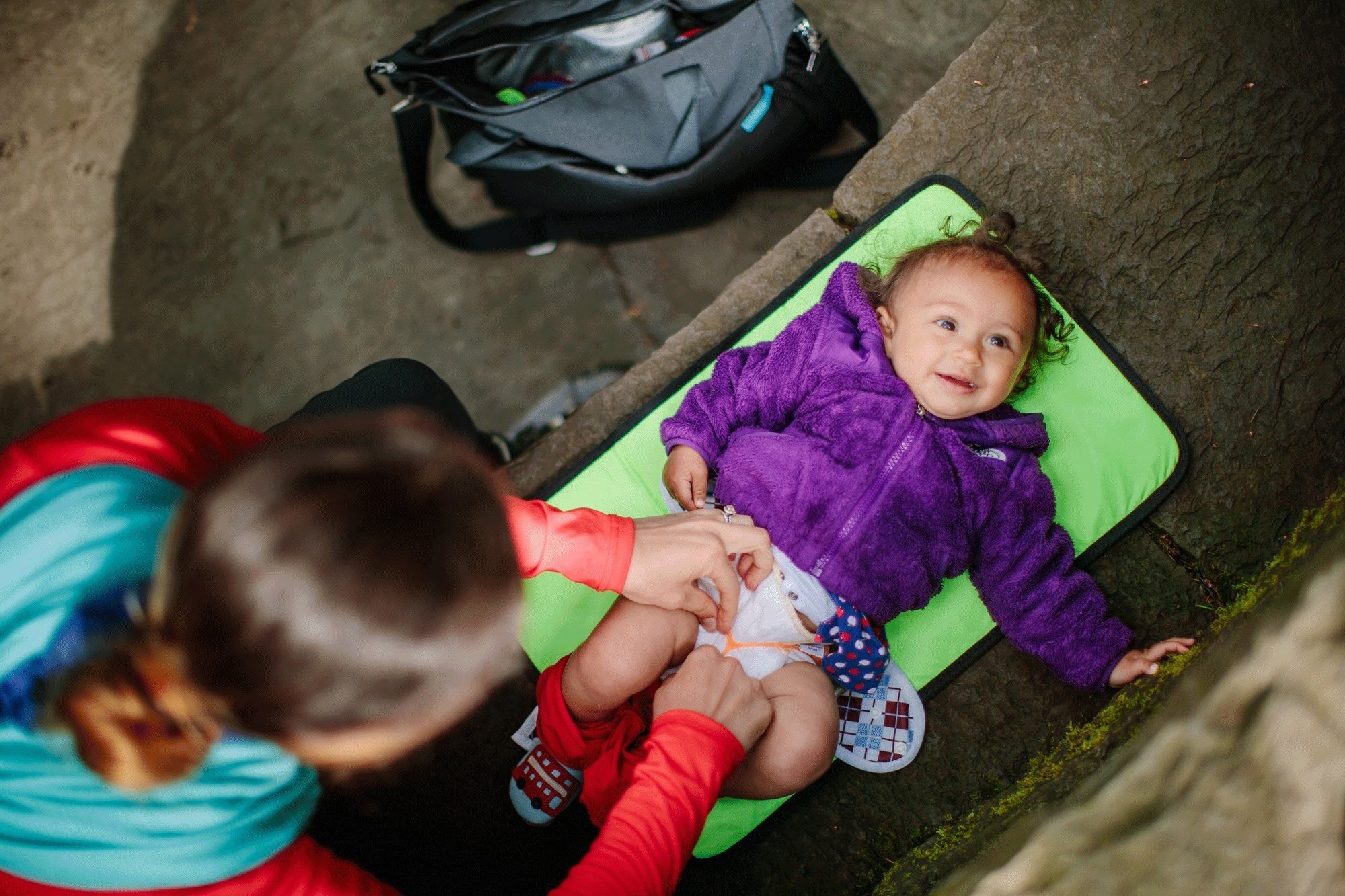When I first started hiking with my infant son, I quickly learned that the farther we went, the more poop became a problem. Digging a cat hole or finding an outhouse is one thing, but when you're hiking with a kid in diapers, it's another story. Trust me when I say there are a million ways diapering on the trail can go wrong—from a complete blowout, up the back and into the hair, to forgetting to bring a diaper, which can cause your tot to turn into a hot, sobbing mess by the time you get back to the car.
Pack the Essentials
The difference between changing on the trail and in town is that you can't just pop into a store if things go wrong. In fact, many families say they prefer hiking in a group for the built-in support when they forget something or run out.
"I always packed like we were going to be gone for two days and during two different seasons," says Christie Vinson, a Hike It Baby ambassador from Richmond, Virginia. "With cloth diapers and a breast-pumped bottle-fed baby, I had a large diaper bag. Eventually I learned that I could leave most of the stuff in the car."

When deciding what goes in the bag, consider the needs of your baby, as well as how far you're going and what amenities you'll have access to when you get there. No matter who you're with or where you're headed, you'll want to bring diapers, wipes, and a way to pack it all out, like a
Having a surface you can lay your child on can be a lifesaver on a rainy day when you find yourself far from a picnic table or other changing surface. Some will tell you they use their soft-structured carrier as a mat, but carriers are often made from cotton and therefore absorb dirt and moisture, making them a less-attractive option. I've found baby poo somehow has a way of going everywhere, especially onto carriers with straps and buckles that aren't easy to clean.
Pick the Perfect Pack
Many caregivers say what stops them from venturing beyond their local park is simply not knowing how to carry all the goods for diapering. This can get tricky when you're carrying your baby with a soft-structured carrier or wrap without pockets that accommodate diapers and wipes. If this is you, consider carrying your baby in the front and a
Decide What Diapers You'll Use
Cloth or disposable? No judgment with either, as I tried both and found disposable worked better for our lifestyle where we were often on the road and laundry could be stacked high for weeks. Vinson, on the other hand, used cloth diapers.
"Hiking with cloth diapers is as normal and easy as hiking with disposables. The only real difference is space. Cloth diapers take up a little more room in your pack," she says.

In my experience, the key to dealing with both cloth and disposable diapers is that aforementioned wet-dry bag for stowing dirty diapers, wipes and soiled clothes. Even after my son grew out of diapers, I found this to be an important item for hiking with kids. Of course, the hope is you won't need it, but a lightweight bag can be perfect for toting puked-up-on clothes and wet or muddy gear—and keeping those messy items away from food and water.
Embrace the Elements
Hiking in inclement weather is totally doable, but because you never know when or where diaper changes are going to happen, it's a good idea to bring a light, portable blanket or small camping towel that can be used as a substitute changing pad. Or get creative. Angela Malson, founder of Eco Womb, says she uses an old computer bag from The North Face with a front that unzips and folds open and can be used as a changing pad to put the baby on.
Remember that if conditions are cold and drizzly, getting naked will be harder on kids. When the forecast predicts rain, throw a waterproof blanket in your pack to put over the baby as they are laying outside on a mat because they may not be wearing much for clothing if they were up against your body. If your baby does have a blowout, their clothes may get wet, causing them to become more susceptible to the cold. After changing, put your tot in some fresh clothes right before the hike starts back up to help minimize this.

If you're hiking in cold temps, you may want to add protection against blowout leakage by investing in cloth diaper hybrids that have additional diaper inserts or fleece or wool diaper covers. That way, if they do have a blowout, you'll still have a warm baby.
You can go lighter in summer because your babe may get hot quickly—especially if you're carrying them against your skin. And heat can lead to rashes.
Rachael Patterson de Azevedo, a Hike it Baby member from Salt Lake City, says she diapers her little one with ointment at the trailhead as a preventative measure before setting out. "Then if your baby or toddler is hot and wet for a long time, their little cheeks have extra protection against chafing," she says.
Find What Works for You
Let's be honest: Poop is kind of gross. It spreads easily, so Hike It Baby parents advise carrying
When toddlers have enough strength to hold themselves up, you can eliminate some of the hassle of changing on the go by having them stand as you change them.
"Learning to change my kids standing up was a game-changer," says Paige Lappen from Los Angeles. "My son's teacher actually showed me how the first time but it worked great on hikes."
How to do it? Lappen has her child stand as she removes his diaper and clean him up. Once the mess is contained, she puts the clean, dry diaper against her knees, and then her child leans or sits into her as she closes up the front.
Potty Training on the Trail
If your toddler is transitioning out of diapers, pack backup diapers or pull-ups and wipes. For some kids, new hiking experiences can be exciting, making bathroom stops low on their priority list. But holding it in can make for a cranky kid. In my experience, it's sometimes just easier to offer your potty-training toddler the option to wear a diaper while they're on the trail. Whether they hike with or without, your future self will thank you when you're prepared for the cleanup.
One last thing to think about when hiking with a baby or toddler is to be cognizant of the waste you're creating. A few families hiking together can generate a lot of trash if multiple kids are in disposable diapers and they're tossing them in park garbage cans. Consider transporting your soiled diapers home from the trailhead to help minimize your impact on the stewards who look after the trail.
Trust me when I say your load will lighten as kids get older. In the meantime, don't be surprised if your little one goes through two to three diapers on a longer hike. Keep it simple, but abide by the Scout motto and always be prepared if you want to have a happy baby on-trail.
